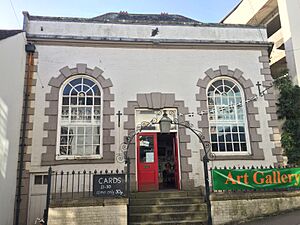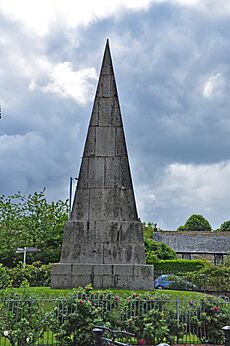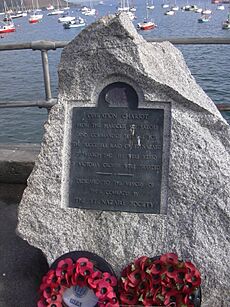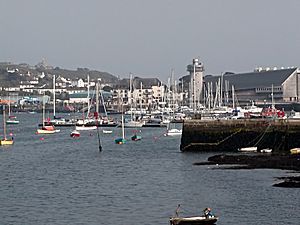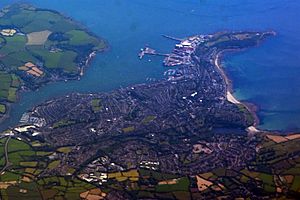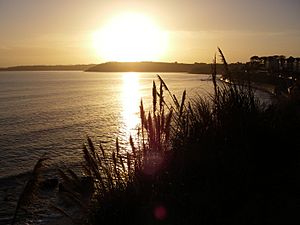Falmouth, Cornwall facts for kids
Quick facts for kids Falmouth
|
|
|---|---|
| Town and civil parish | |
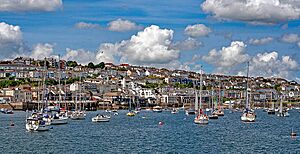 Falmouth viewed from the estuary |
|
The council's logo |
|
| Population | 24,071 (2021) |
| OS grid reference | SW810325 |
| Civil parish |
|
| Unitary authority | |
| Ceremonial county | |
| Region | |
| Country | England |
| Sovereign state | United Kingdom |
| Post town | FALMOUTH |
| Postcode district | TR11 |
| Dialling code | 01326 |
| Police | Devon and Cornwall |
| Fire | Cornwall |
| Ambulance | South Western |
| EU Parliament | South West England |
| UK Parliament |
|
| Website | falmouthtowncouncil.co.uk |
Falmouth is a lively town, civil parish and port located on the River Fal in Cornwall, England. It is found on the beautiful south coast of the United Kingdom.
Falmouth was started in 1613 by the Killigrew family. It grew up around Pendennis Castle, which was already there. The town became a very important port on the Carrick Roads harbour. It even became more important than the older town of Penryn. In the 1800s, when railways arrived, tourism became a big part of Falmouth's economy. Today, both shipping and tourism are still important. Falmouth is also home to the National Maritime Museum Cornwall, a campus of Falmouth University, and Falmouth Art Gallery.
Contents
What's in a Name?
The name Falmouth comes from English. It simply means the town is at the mouth of the River Fal. In the Cornish language, the name is Aberfal or Aberfala. This means the exact same thing!
A Look Back in Time
Early Beginnings
In 1540, King Henry VIII built Pendennis Castle in Falmouth. This was to protect Carrick Roads. At that time, the main town nearby was Penryn. A map from the late 1500s shows a manor house called 'Arweneck'. There were also some small homes at 'Smithick, alias Pennycomequick'. This area is near today's Market Strand. Pennycomequick is an English version of the Celtic Pen-y-cwm-cuic, meaning 'head of the creek'. There's even a place called Pennycomequick in Plymouth today.
In the late 1500s, when the Spanish Armada was a threat, Pendennis Castle's defenses were made stronger. During the Civil War, Pendennis Castle was one of the last forts to give up to the Parliamentary Army. Sir John Killigrew officially started the town of Falmouth just after 1613.
After the Civil War, Sir Peter Killigrew received royal support. He gave land to build the Church of King Charles the Martyr. This church was dedicated to King Charles I, who was called "the Martyr."
The town's official seal showed an eagle with two heads. Each wing had a tower on it. This was based on the Killigrew family's coat of arms.
Falmouth was very important because it was the closest large harbour to the English Channel. Two Royal Navy groups were always stationed here. In the 1790s, one group was led by Sir Edward Pellew. The other was led by Sir John Borlase Warren. Each group had five frigates, which are types of warships. During the French Revolutionary Wars, many ships arrived with prizes taken from French ships and prisoners of war. Near Penryn, there were two large camps for French prisoners.
The Old Town Hall on High Street was finished in 1710. Later, in 1866, the town council moved to a new town hall on The Moor. This building is now called the Palacio Lounge.
The Falmouth Packet Service ran from Falmouth for over 160 years. This was from 1689 to 1851. Its job was to carry mail to and from Britain's growing empire. By the late 1700s, there were thirty to forty small, three-masted ships. The crews were carefully chosen. Both officers and men often made a lot of money from illegal trading. They could do this because they were government ships and were not searched by customs.
The 1800s and 1900s
In 1805, news of Britain's victory and Admiral Nelson's death at Trafalgar reached Falmouth. This news came from the schooner Pickle. It was then taken to London by post chaise. On October 2, 1836, HMS Beagle anchored at Falmouth. This was at the end of its famous trip around the world. That evening, Charles Darwin left the ship. He took a Mail coach to his family home. The ship stayed a few more days. Captain Robert FitzRoy visited the Fox family at nearby Penjerrick Gardens.
In 1839, Falmouth was the site of a gold dust robbery. A large amount of gold dust from Brazil was stolen when it arrived at the port.
The Falmouth Docks were built starting in 1858. The Royal National Lifeboat Institution (RNLI) opened Falmouth Lifeboat Station nearby in 1867. The current building was built in 1993. It also houses Her Majesty's Coastguard. The RNLI has two lifeboats in Falmouth. One is a large all-weather boat, and the other is a smaller inshore lifeboat.
Near the town centre is Kimberley Park. It is named after the Earl of Kimberley. He leased the land for the park to the town. Today, the park has beautiful and unusual plants and trees.
The Cornwall Railway reached Falmouth on August 24, 1863. The railway brought new wealth to Falmouth. It made it easy for tourists to visit the town. It also allowed goods from the port to be moved quickly. The town now has three railway stations. Falmouth Docks railway station is the original end of the line. It is near Pendennis Castle and Castle beach. Falmouth Town railway station opened in 1970. It is good for visiting the National Maritime Museum Cornwall, the waterfront, Gyllyngvase beach, and the town centre.
Penmere railway station opened in 1925. It is in the north of Falmouth. All three stations have regular trains from Truro on the Maritime Line.
Falmouth saw a total eclipse of the Sun on August 11, 1999. This happened at 11:11 a.m. The eclipse lasted just over two minutes in Falmouth. This was the longest time it could be seen in the United Kingdom.
World War II History
During World War II, 31 people in Falmouth were killed by German bombing. An anti-submarine net was placed from Pendennis to St Mawes. This was to stop enemy U-boats from entering the harbour.
Falmouth was the starting point for the St Nazaire Raid in 1942. From 1943 to 1944, Falmouth was a base for American troops. They were getting ready for the D-Day invasions. Many troops left from Falmouth harbour and the nearby rivers. There are special plaques at Turnaware Point, Falmouth Watersports marina, Tolverne, and Trebah gardens. The United States Navy also had a large base in Falmouth harbour.
After the War
The SS Flying Enterprise was a cargo ship. It sailed from Hamburg in December 1951. It ran into a big storm near the English Channel. A crack appeared on its deck, and the cargo moved. Many ships tried to help, including the tugboat Turmoil from Falmouth. The ship finally sank in January 1952. The captain and a crew member were rescued and brought to Falmouth as heroes.
Old Estates
- Arwenack was a large estate that was on the site before Falmouth became a town. It was the home of the Killigrew family for a long time. Only a small part of it remains today.
How Falmouth is Governed
Falmouth Town is a civil parish within Cornwall. It was created in 1974 from the old Falmouth Borough Council. Falmouth received its official town charter in 1661.
As of 2024, Falmouth is run by sixteen councillors. Four councillors represent Arwenack and Boslowick. Five represent Penwerris, and three represent Trescobeas. Each councillor serves for four years. The town council provides local services. Bigger services for all of Cornwall are handled by Cornwall Council.
Jobs, Businesses, and Visitors
Falmouth's shipping business is not as big as it used to be. However, the docks are still very important for the town's economy. It is the largest port in Cornwall. Falmouth is still a cargo port. Ships are refuelled and goods are moved, keeping the port busy. The port is also popular with large cruise ships.
Further up the calm waters of the River Fal, you can often see several ships. They are waiting for new orders or owners.
Falmouth is a popular place for holidays. It is now mainly a tourist town. There are five main beaches near Pendennis Castle. These are Castle, Tunnel, Gyllyngvase, Swanpool, and Maenporth beaches. The National Maritime Museum Cornwall opened in February 2003. The building was designed by architect M. J. Long.
The Falmouth & Penryn Packet newspaper was first printed in 1858. It is still based in the town today. It is the main newspaper in a series of Packet Newspapers for central and western Cornwall.
Fun and Culture
Falmouth has many connections to books and stories. The town was the birthplace of Toad, Mole, and Rat. These characters are from Kenneth Grahame's classic book, The Wind in the Willows. The first two letters that became the book were written in Falmouth in 1907. Copies of these letters are on display at the Greenbank Hotel. Poldark author Winston Graham knew Falmouth well. He set his novel The Forgotten Story (1945) in the town.
The town has been used as a setting for several movies and TV shows. British film star Will Hay was often seen in Falmouth in 1935. He was filming his comedy Windbag the Sailor. The film showed many scenes of the docks. The docks were also featured in the 1948 film Scott of the Antarctic. Stars from the 1950 Walt Disney film Treasure Island visited the town. Some scenes were filmed along the River Fal. In 2011, Paramount Pictures filmed parts of the movie World War Z in Falmouth Docks. This movie starred Brad Pitt.
Falmouth had the first "Polytechnic" in the country. This was the Royal Cornwall Polytechnic Society. It is now an important part of the town. It often has art shows, stage plays, and an art house cinema.
Falmouth is home to many theatre groups. These include Falmouth Theatre Company, Falmouth Young Generation, and Amity Theatre. Falmouth Theatre Company, or FTC, is the oldest local group. They have been performing since 1927.
The Falmouth Art Gallery is a public gallery. It has a varied collection of art from the 1800s and 1900s. Many famous modern Cornish artists are shown there. The gallery has four to five new exhibitions each year. It also has free, family-friendly education programs for the community and schools.
Falmouth has its own community radio station called Source FM. You can listen to it on 96.1 FM or online.
In 2016, Falmouth won the "Great British High Street 2016" award. It won in the 'Coastal Community' group.
Places of Worship
The main Anglican churches are dedicated to King Charles the Martyr and to All Saints. A third church is St Michael's Church, Penwerris. The Roman Catholic church of St Mary Immaculate is on Killigrew Street. It was built in 1868. The tower and spire were added later. The church mixes Gothic and French Romanesque styles.
Falmouth Methodist Church is also on Killigrew Street. Its front is very grand. The United Reformed Church is in Berkeley Vale. The old synagogue, built in 1816, is one of the oldest synagogue buildings still standing in England. It was used until 1879.
Getting Around Falmouth
Falmouth Harbour
Falmouth is famous for its harbour. Along with Carrick Roads, it forms the third deepest natural harbour in the world. It is the deepest in Western Europe. Many famous round-the-world voyages have started or finished here. These include trips by Robin Knox-Johnston and Dame Ellen MacArthur.
Roads
Falmouth is at the end of the A39 road. This road connects to Bath, Somerset. The A39 also links Falmouth to the A30 through Truro. The A30 provides a fast way to get to the M5 motorway at Exeter.
Most public bus services are run by First Kernow. Other services are provided by Office & Transport Services for Transport for Cornwall.
Trains
Falmouth has three railway stations. They are at the southern end of an 11.75-mile (18.9 km) branch line called the Maritime Line from Truro. The train ride takes about 28 minutes to Falmouth and 24 minutes back. It stops at Perranwell, Penryn, Penmere, Falmouth Town, and Falmouth Docks.
Ferries
Falmouth has regular ferry routes. These connect to St Mawes, Flushing, Trelissick, Malpas, and Truro.
Learning in Falmouth
There are five primary schools in Falmouth. There is also one secondary school, called Falmouth School.
Falmouth University has a campus in the original town area, Woodlane. It also has another campus at Tremough, Penryn. This campus is shared with the University of Exeter. The university offers courses mainly in Art, Design, and Media. The University of Exeter, Cornwall Campus offers many courses. These often focus on the environment and how to live sustainably. It also hosts the famous Camborne School of Mines. This school teaches about Earth's natural processes, resources, and the environment.
In 2015, the actor and comedian Dawn French became the chancellor of Falmouth University.
Falmouth Marine School used to be Falmouth Technical College. It teaches about old and new boat-building, marine engineering, and marine sports. This campus is part of Cornwall College.
Sports and Fun
The town has a football team, Falmouth Town A.F.C.. They play in the Western Football League at Bickland Park. There is also Falmouth RFC, a rugby union club. They play at The Recreation Ground.
Falmouth is also home to one of Cornwall's biggest cricket clubs. Four teams play for the town in the Cornwall Cricket League. The first team plays in the Cornwall Premier League. Falmouth CC plays at the Trescobeas ground.
Because it is near both calm and open waters, Falmouth is a popular place for boating and water sports. It is a centre for Cornish pilot gig rowing. It is also home to Gyllyngvase Surf Life Saving Club, started in 2008. It is a popular spot for sea swimming. In 1965, solo sailor Robert Manry crossed the Atlantic. He sailed from Falmouth, Massachusetts (which is named after Falmouth) to Falmouth, Cornwall. He did this in his 13.5-foot boat, Tinkerbelle. This was the smallest boat to make the crossing at the time.
The town has hosted The Tall Ships' Race several times. This is a race where many large sailing ships, called Tall Ships, set sail. Falmouth hosted the race in 1966, 1982, 1998, 2014, and the start of the 2021 race.
Cornish Wrestling
Falmouth has been a major place for Cornish wrestling for hundreds of years. Tournaments were often called "the championship of the West of England." Matches were held in different places around town, including Pendennis Castle. Alfred Ernest Trenoweth (1868–1942) from Falmouth was a well-known lightweight champion wrestler of Cornwall. He was also a carpenter and the lightweight boxing champion of Kent. Another champion wrestler from Falmouth was Pellew. He was special because he only had one arm!
Weather in Falmouth
| Climate data for Falmouth (1916–1995 averages) | |||||||||||||
|---|---|---|---|---|---|---|---|---|---|---|---|---|---|
| Month | Jan | Feb | Mar | Apr | May | Jun | Jul | Aug | Sep | Oct | Nov | Dec | Year |
| Mean daily maximum °C (°F) | 9 (48) |
9 (48) |
10 (50) |
12 (54) |
14 (57) |
17 (63) |
19 (66) |
19 (66) |
17 (63) |
14 (57) |
12 (54) |
10 (50) |
14 (56) |
| Mean daily minimum °C (°F) | 6 (43) |
5 (41) |
6 (43) |
7 (45) |
10 (50) |
12 (54) |
14 (57) |
14 (57) |
13 (55) |
11 (52) |
8 (46) |
7 (45) |
9 (49) |
| Average precipitation mm (inches) | 109.3 (4.30) |
83.1 (3.27) |
78.3 (3.08) |
67.7 (2.67) |
62.6 (2.46) |
57.5 (2.26) |
61.5 (2.42) |
64.2 (2.53) |
73.3 (2.89) |
107.4 (4.23) |
113.7 (4.48) |
118.2 (4.65) |
996.8 (39.24) |
| Mean monthly sunshine hours | 56.7 | 73.8 | 121.4 | 178.3 | 213.8 | 215.0 | 205.0 | 195.7 | 147.1 | 106.0 | 69.4 | 53.7 | 1,635.9 |
Famous People from Falmouth
- Josiah Fox (1763–1847) was a British naval architect. He helped design and build the first six frigates for the United States Navy.
- Robert Were Fox the Younger (1789–1877) was a British geologist and inventor. He studied the Earth's temperature and created a special compass for ships.
- Charles Napier Hemy (1841–1917) was a British painter known for his marine (sea) paintings. He moved to Falmouth in 1881.
- Henry Scott Tuke (1858–1929) was an English artist, mainly a painter, but also a photographer.
- Joseph Conrad (1857–1924) was a famous writer. He stayed in Falmouth for nine months in 1882. He later wrote a short story called Youth about his time there.
- Colonel James Power Carne (1906–1986) was an Army officer. He received the Victoria Cross for his bravery in the Korean War.
- Sebastian Newbold Coe, Baron Coe (born 1956), also known as Seb Coe, is a British politician and former athlete. He won four Olympic medals in running. He was also a Member of Parliament for Falmouth.
- Paul Martin (born 1959) is an antiques dealer and TV presenter. He presents BBC antiques shows like Flog It!. He went to Falmouth Grammar School.
- Matthew Etherington (born 1981) is a footballer. He played for Falmouth Town under 14s before playing for bigger clubs like Tottenham Hotspur and West Ham.
Places to See
Falmouth's Twin Towns
Falmouth is twinned with two other towns:
- Douarnenez in Brittany, France
- Rotenburg an der Wümme, in Lower Saxony, Germany
See also
 In Spanish: Falmouth para niños
In Spanish: Falmouth para niños


